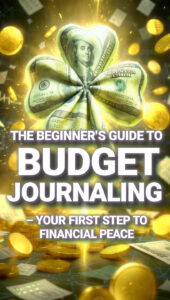Now Reading: THE BEGINNER’S GUIDE TO BUDGET JOURNALING — YOUR FIRST STEP TO FINANCIAL PEACE 🧘♀️💵
-
01
THE BEGINNER’S GUIDE TO BUDGET JOURNALING — YOUR FIRST STEP TO FINANCIAL PEACE 🧘♀️💵
THE BEGINNER’S GUIDE TO BUDGET JOURNALING — YOUR FIRST STEP TO FINANCIAL PEACE 🧘♀️💵
Let’s be real, babe — budgeting can feel cold, confusing, and downright overwhelming.
Spreadsheets don’t feel personal. Apps get ignored.
But a budget journal? That’s your sacred little space where your money meets your emotions.
Whether you’re trying to stop living paycheck to paycheck, pay off debt, or just feel less ugh when you check your bank account — this guide is for you. 💗

🖋️ What Exactly Is Budget Journaling?
Budget journaling is more than just writing numbers.
It’s about tracking your money with heart, intention, and self-awareness.
Think of it like this:
📓 Budget Journal = A mix of a money tracker + emotional check-in + future goals — all handwritten by you, for you.
It’s where you:
-
Write down what you spent — without guilt
-
Set intentions, not just “rules”
-
Celebrate tiny wins (“Didn’t order Starbucks today!”)
-
Process emotional spending triggers
-
Stay consistent — even if you make mistakes
💡 This isn’t budgeting like a finance bro. This is budgeting like a healing woman. 🦋
💫 Why Every Beginner Should Start Here
Let’s be honest — budgeting apps often disconnect us from how and why we spend.
But writing things down slows you down. It grounds you.
And when your income is tight, or life feels chaotic, a journal brings clarity like nothing else.
Here’s what a budget journal gives you that apps can’t:
-
✍️ Mindful money tracking
-
🌙 A safe place to reflect on spending habits
-
🎯 Visual progress toward goals
-
💖 Daily financial self-love
📚 Supplies You’ll Need (Don’t Worry, It’s Budget-Friendly 😉)
You don’t need a $60 planner.
You need a notebook and your favorite pen. That’s it.
But if you wanna get aesthetic, here’s a lil’ list:
✔️ A blank or dot-grid notebook
✔️ Colored pens or highlighters
✔️ Washi tape / stickers (optional but ✨cute✨)
✔️ Ruler for neat columns
✔️ Your monthly bills & income info
This is your journal — make it feel like home.
🧩 What to Include in Your Budget Journal
You don’t have to be perfect — just intentional.
Here’s a simple structure to begin with:
1. Monthly Overview Page
-
Your income (if it’s irregular, use a rough estimate)
-
Fixed expenses: rent, utilities, debt, subscriptions
-
Variable expenses: groceries, gas, eating out
-
Savings/debt payoff goal for the month
2. Daily or Weekly Spending Log
Write everything. Yes, even the $2.79 iced coffee.
You’ll be surprised what awareness alone can shift.
3. No-Spend Challenge Tracker
Use stickers or a cute symbol to mark no-spend days.
Even 3-5 no-spend days a month can move the needle.
4. Sinking Fund Tracker
Want to save for Christmas, vacation, or car repairs?
Create little boxes to color in as you save.
It’s fun, visual, and so satisfying.
5. Emotional Money Check-In
Write how you felt about your spending this week.
Did you overspend after a rough day? Did you save even when it was hard?
✨ That’s the real work, queen.
🌸 A Little Pep Talk Before You Start
If you’ve ever felt like “I’m just bad with money”… please stop.
You are not bad with money — you just never had a money system that loved you back.
Budget journaling is your soft start.
No pressure. No judgment. Just you, your pen, and your power.
So light a candle, pour a tea, and give your budget a hug — not a punishment. 💕
You’ve got your journal. You’ve started writing.
But now you’re wondering — how do I keep this up?
How do I make this a loving, lasting habit instead of just another to-do I forget?
That’s exactly what this part is for.
Let’s create rituals, routines, and reflections that make budget journaling feel like self-care — not self-criticism.
🕯️ Create a Weekly “Money Ritual” (It’s Not as Woo-Woo as It Sounds)
Budget journaling isn’t just about math. It’s about mindset.
So make it a vibe. Make it sacred. Make it yours.
Pick one day a week (like Sunday morning with coffee or Friday evening with wine), and:
-
Light a candle
-
Open your journal
-
Play soft music
-
Review your week — what came in, what went out
-
Write 3 words about how you feel about your money this week
-
Set an intention for next week
💬 Example:
“This week felt rushed and reactive. Next week, I want to spend only on things that bring me peace.”
This isn’t about guilt — it’s about grace. 🙏
📖 Page Prompts That Keep You Connected (Not Confused)
Not sure what to write each week? Here are some gentle, heart-led prompts you can use in your budget journal:
-
✍️ “What spending made me happiest this week?”
-
✍️ “Where did I spend emotionally instead of intentionally?”
-
✍️ “One small win I’m proud of…”
-
✍️ “One financial habit I want to improve…”
-
✍️ “What’s something free that brought me joy?”
Use these once a week or even daily.
They build awareness, and awareness builds change.
💡 Real Layout Ideas You Can Try (Visual + Simple)
You don’t need to be artistic — just a little consistent.
Try these easy page ideas:
🔹 Monthly Budget Spread
Draw boxes for:
-
Income streams
-
Fixed costs
-
Variable costs
-
Debt payments
-
Savings goals
Make it pretty with highlighters or stickers if that helps you stay inspired!
🔹 Expense Tracker (Color-Coded)
Use different ink colors for:
-
Needs (blue)
-
Wants (pink)
-
Regrets (gray)
This alone can shift your mindset big time.
🔹 Habit Tracker for Money Moves
Create a grid for:
-
No-Spend Day ✅
-
Journaled Today ✅
-
Checked Bank Balance ✅
-
Packed Lunch ✅
Tracking daily wins keeps motivation alive.
🤍 What To Do When You “Fall Off” or Overspend
Let’s be honest — you will have messy weeks.
But that doesn’t mean you’ve failed.
It means you’re human.
Here’s how to bounce back with love:
-
Open your journal without shame.
-
Write: “I forgive myself for…”
-
Then write: “Next time, I will try…”
-
And finally: “One thing I did right was…”
💬 Example:
“I forgive myself for impulse shopping when I was sad.
Next time, I’ll call a friend or go for a walk first.
But I’m proud I still tracked it in my journal.”
That’s growth, sis. That’s healing. 🌱
🌺 How Budget Journaling Helps You Emotionally Heal
Let’s go deeper for a second.
Many of us grew up with money shame, scarcity, or silence.
We were never taught to talk to money, let alone feel safe with it.
Budget journaling is how you begin rewriting that story.
It’s how you:
-
🌷 Reconnect with your inner child who just wanted safety
-
🌷 Break generational money trauma
-
🌷 Remind yourself: You are worthy of stability, joy, and overflow
So every time you pick up that pen, you’re not just budgeting.
You’re reclaiming power.
🌈 Final Gentle Reminder
Your budget journal doesn’t have to be perfect.
It just has to be yours.
Messy pages? Still valid.
Skipped a week? Come back.
Overspent? Learn and move on.
This is a journey of progress, not perfection.
And girl — you’re already doing better than you think. 💕














